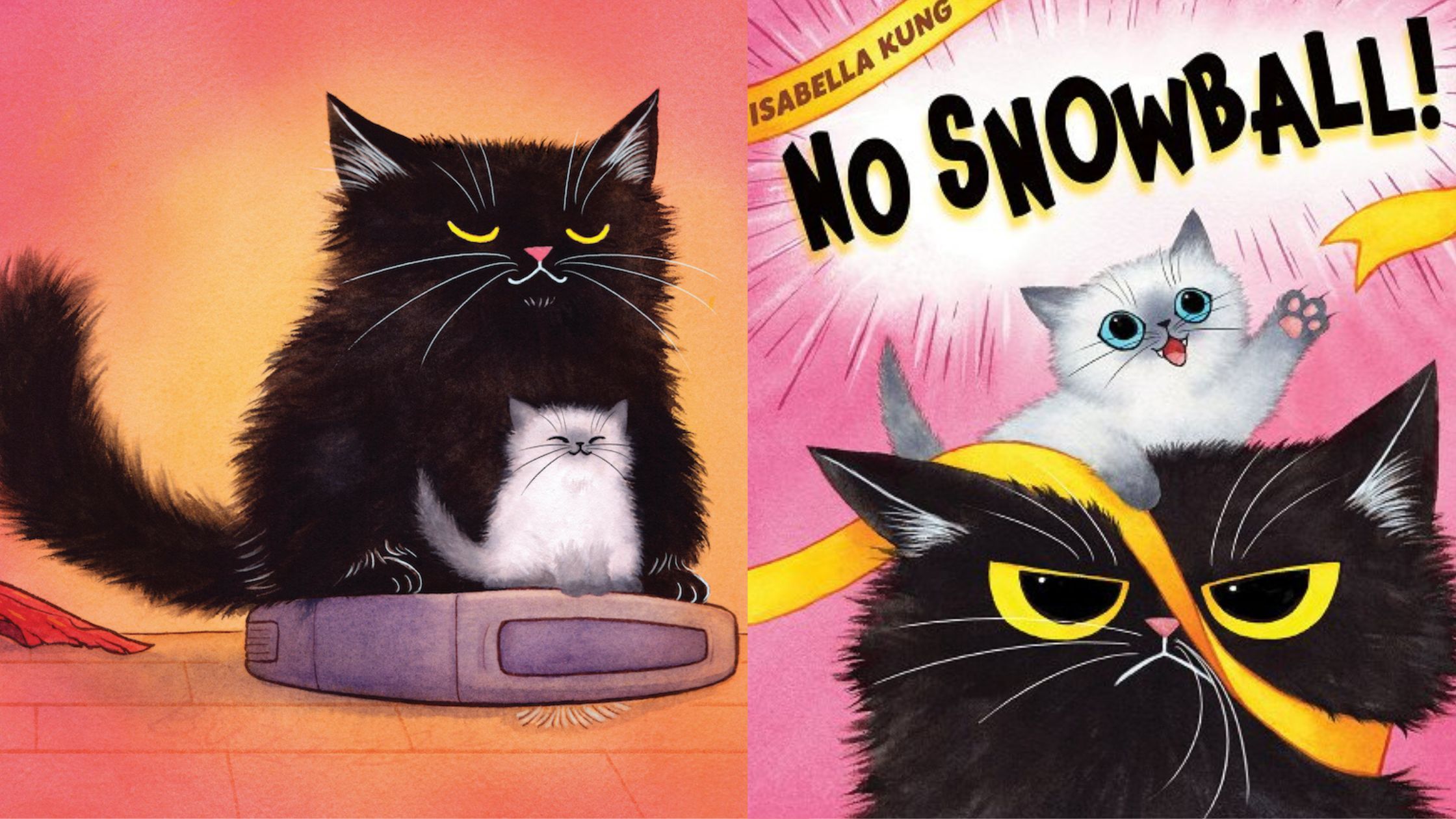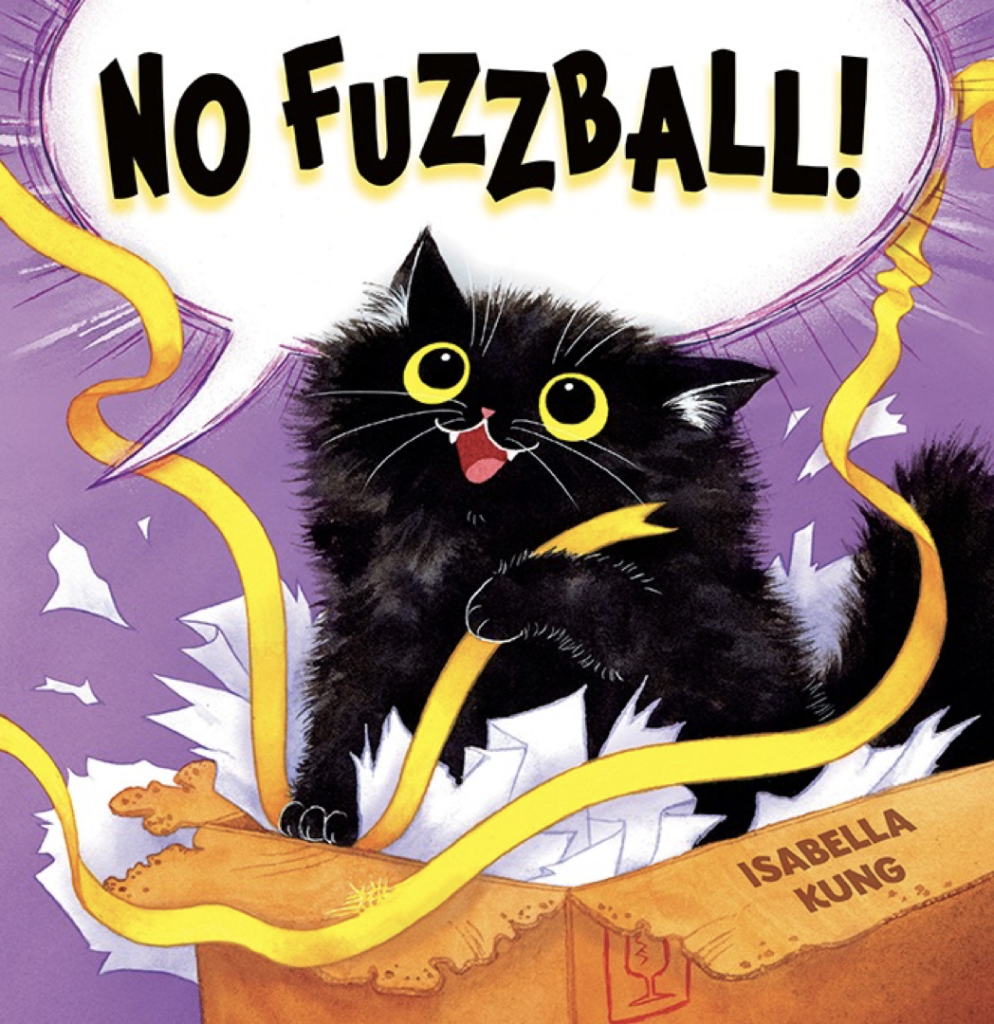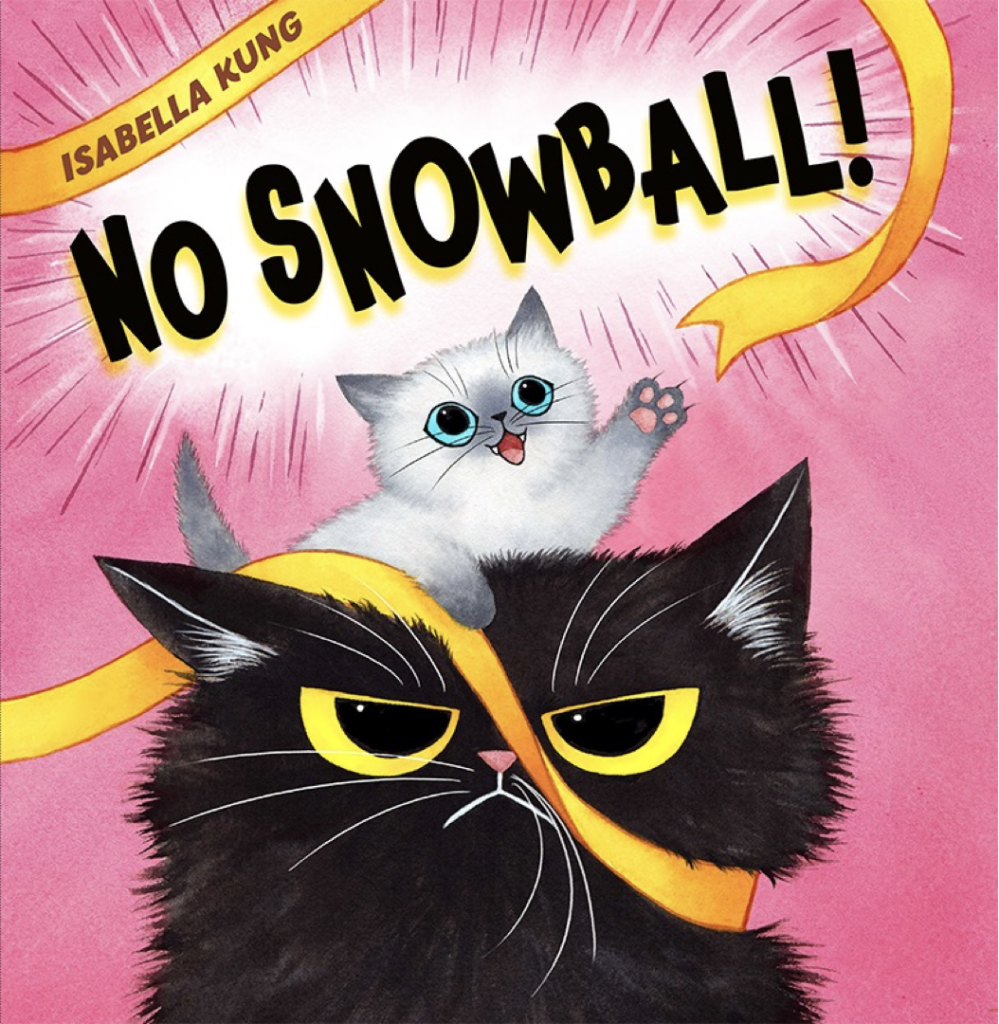craft review by Kristi Wright
As Isabella Kung mentioned in our KidLitCraft interview last week, her Fuzzball character started life as an adorable set of emojis. From there, Fuzzball gained additional fans in her sticker incarnation–I was an early owner of Fuzzball stickers. Finally in 2020, Fuzzball took center stage in her first picture book: NO FUZZBALL! Now, in 2022, a much anticipated sequel has arrived–NO SNOWBALL! Suddenly, Fuzzball must navigate the inconceivable–there’s someone new vying for everyone’s attention. Fuzzball being Fuzzball, she knows just what to do.
Dramatic Irony in NO FUZZBALL!
Isabella Kung’s debut author-illustrator picture book NO FUZZBALL! is a masterclass in how to use dramatic irony to tell a laugh-out-loud comedic story using a well orchestrated combination of words and images.
Quick refresher: dramatic irony is a literary device that lets the reader in on information, while keeping the main character in the dark. It’s a great technique for humor.
In NO FUZZBALL!, our hilarious protagonist thinks, as queen of the house, she’s being lavished with adoration by all her subjects because they constantly yell “NOFUZZBALL!” at her. She thinks “NoFuzzball” is her name–well, actually, as far as she’s concerned, she’s Queen NoFuzzball. However, where she sees adoration, the reader is fully aware that Fuzzball’s subjects are actually begging her to stop her somewhat destructive behavior! Comedic gold.
NO SNOWBALL!, Isabella Kung’s sequel to NO FUZZBALL! stays true to its dramatic irony roots, while adding contrast for great comedic effect and all around adorableness.
Continuing the Dramatic Irony in the Sequel
In NO SNOWBALL!, a new kitty enters Fuzzball’s domain. At first, Fuzzball is highly irritated by what she perceives as a threat to her throne. But soon she reconsiders and instead decides to teach the new little fluff ball how to be her princess. The readers understand that Fuzzball is training Snowball to be naughty like her, but Fuzzball and Snowball are in their own world where they have no knowledge of how they are being perceived by the family they live with, let alone the readers. This dramatic irony heightens the hilarity and gives young readers the joy of knowing more than the characters about what’s going on.
For example, a big moment in the book is when Fuzzball attempts to teach Snowball how to use her “weapons.” Fuzzball insists that to be a proper princess, Snowball should be able to shred the curtains with her weapons, otherwise known as claws, but Snowball gets stuck up high on the curtains instead. Readers of all ages know that shredding the curtains is a bad idea, but there’s so much comedic fun in Fuzzball’s sincere training of her new princess. Kung’s commitment to Fuzzball’s skewed perception of the world guarantees laughs.
And her illustrations reinforce the dramatic irony.
One of my favorites is the last one where Queen NoFuzzball and Princess NoSnowball are together riding a robot vacuum as if it’s their royal carriage. You can tell from their proud and satisfied expressions that they have no doubt this vehicle was made to be of service to them, but the reader knows it’s just a robot vacuum–an image guaranteed to elicit a giggle.
Dramatic irony works best when most readers can appreciate the subtext of the situation. Even very young children can grasp situations that might be considered naughty (like shredding curtains), scaring people, and generally causing chaos. They also know better than most what it’s like to be little. Kung doesn’t have to explain anything. Fuzzball’s misbelief about her role in the family and her attempts to turn Snowball into a “mini-me” are so recognizable, that spare text and hilarious illustrations are all that’s needed to land the humor.
NOTE: While an author-illustrator has a lot of leeway in amping up dramatic irony via a combination of text and illustrations, text-only picture book writers have opportunities to use dramatic irony as well. Even without the illustrations, Queen NoFuzzball’s strong voice still lands the main joke that hinges on her skewed perception of the world. And while agents and editors often discourage the use of art notes, they understand the judicious use of those that suggest opportunities for dramatic irony in the illustrations. With that said, illustrators are generally brilliant and will find countless opportunities for dramatic irony all on their own!
Adding Contrast to Great Effect
Queen “NoFuzzball” is a large and fluffy black cat with attitude whereas Snowball (eventually dubbed Princess “NoSnowball”) is a tiny, fluffy white kitten who hero worships Fuzzball from the get-go. This initial contrast immediately garners a strong “aww” factor. But it also plays for laughs. And Kung ensures that Fuzzball and Snowball contrast in all ways. Fuzzball is an adult cat; Snowball is a kitten. Fuzzball has “skills;” Snowball is doing everything for the first time. Fuzzball is grumpy and dramatic; Snowball is adoring and optimistic. These contrasts amp up the humor and cuteness in every spread.
Early on, Fuzzball mentors Snowball on how to be stealthy. Kung perfectly captures how a kitten might attempt to hide (and likewise how a small child might go about it.) No matter how hard Snowball tries, she’s highly visible. And the image of a tiny kitten attempting and failing to hide in the toilet is priceless–especially when juxtaposed with savvy Fuzzball who would never make such a rookie mistake.
Contrasting characters make excellent foils for each other. Their differences can provide tension and humor as well as heart. Kung’s masterful juxtaposition of Fuzzball and Snowball in words and in illustrations provides another layer of humor and cuteness.
NOW IT’S YOUR TURN
- Consider your own stories. Are there elements that can take advantage of dramatic irony? When we say children are sponges, it’s not just hyperbole. They know plenty. Look for opportunities to let them in on a joke while keeping the main character–or any character, for that matter–in the dark.
- Are you taking full advantage of contrast as you develop your characters? Let them be different. Lean into those differences. Use the differences to amp up the humor, tension, and heart of your stories.
To read more about effective use of character contrast, see this KidLitCraft post about picture book Ginger and Chrysanthemum by Kristen Mai Giang and Shirley Chan. And this post explores dramatic irony in middle grade novel The Lonely Heart of Maybelle Lane by Kate O’Shaughnessy.
Kristi Wright (co-editor) writes picture books and middle grade novels. Her goal as a writer is to give children a sense of wonder, a hopefulness about humanity, and a belief in their future. She is represented by Kurestin Armada at Root Literary. She is an active volunteer for SCBWI and a 12 X 12 member. Find her at www.kristiwrightauthor.com and on Twitter @KristiWrite.




COMMENTs:
0